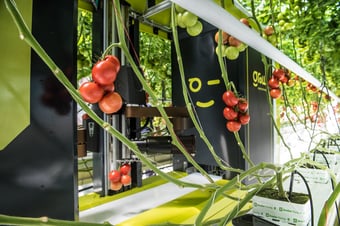In a constantly innovating sector like horticulture, keeping up with the latest labour-saving technology is imperative. Breakthroughs in automation, vision technology, artificial intelligence and machine learning have the potential to revolutionise plant cultivation and harvesting.
For future-thinking growers, now is the time to take a closer look at the development of robotics technologies and their potential in horticulture. This article covers the three basic steps for greenhouse companies to get started with greenhouse robotics, and why an investment in the GRoW robot platform is an investment in a fruitful future.
Step 1: Get your greenhouse and infrastructure robotics ready
The journey to seamless integration of automation and robotics starts with the design of the greenhouse itself. The first thing any organization must do is survey the setup of its current operations. Though there are, in most cases, no formalized industry standards for greenhouses, yet there are technical and structural considerations to ensure that any robotics solution doesn’t require costly foundational greenhouse architectural changes. Today’s typical high-tech greenhouses with concrete central-aisles and a tube rail heating systems allow for easy integration of robotics.
Once a full survey of the greenhouse has been done, it’s time to take the next step to installing robotics.
Step 2: Make sure you have a scalable variety of seeds available for robotic harvesting
There have been many developments of robots that can perform automated tasks in the greenhouse. When it comes to harvesting, these fall into one of two categories. First there are robots that harvest a single fruit - for example strawberries. These robots are focused on picking each individual fruit from the crop or vine. Then there are robots that focus on trusses, such as tomatoes on the vine (TOV) - or bunch tomatoes.
As a specialized tomato harvesting robot, GRoW falls into the second category. These types of robots can be very useful for situations where the TOV’s of the crops are picked and transported to a pack house in reusable packaging containers. When the produce reaches the packing station, the trusses will receive another quality and weight check before they are packed into their final retail packaging, such as clamshells or flow-packaging.
The choice of variety and harvesting and handling processes greatly impacts the application of robotics in the greenhouse. The best practice for robotics beginners is to consider various options, and the pros and cons of each variety ensure a good fit for your specifications.
Step 3: Rethink your picking process for fully automated greenhouse benefits
Integrating robotics into the greenhouse can seem overwhelming at first, but the transformational impact it can have on your entire operations process can’t be understated. An important step to help seamlessly integrate robotics into the greenhouse is to rethink your picking process and be open to new possibilities.
As a very labour-intensive process picking usually relies on manual work that has limitations, such as an 8 hour work day or shift work. Robotics are not limited to 8 hours a day of harvest and can work - for example - 16 hour shifts, 7 days a week.
Along with more available picking hours, greenhouse robots have been proven to pick a crop to a more precise colour scale than the human eye. This gives growers more flexibility to fulfill specific customer requests. This, naturally, will transform your marketing opportunities and lead to overall greater accuracy, consistency, and in turn, customer satisfaction and retention.
Be ready to change the way teams are managed to integrate the GRoW robot and feel the full benefits. By investing early, CTOs will be helping to push the current version of the greenhouse robot to completion while driving innovation towards future versions that incorporate new features like plant diagnostics and targeted application of pest control or nutrients.
While it may be tough to predict exactly what future iterations of a greenhouse robot will look like or what it may be capable of, one thing that is clear is that robots are here to stay.
Future-proof your business now by investing early in the GRoW robot platform
The use of robots in greenhouses is an investment in the future from a sustainability point of view. Robotics will allow you to grow more with less. You can expand your company without having to grow your workforce, or having to worry about finding skilled labour. Investing in robotics is also investing in a sustainable workspace for your human workers; they can be deployed more effectively in better working conditions performing less strenuous and repetitive tasks.
Being an early investor in a robot platform may seem daunting, however, investing in a platform now is investing in the future. Investing early on creates the opportunity to help shape what the final platform will look like. The producers that invest in the greenhouse robot technology early on are contributing to innovations that will eventually shape the future of the horticulture industry.
Take your first action toward transforming your greenhouse with high-tech automation. Download the whitepaper here:




